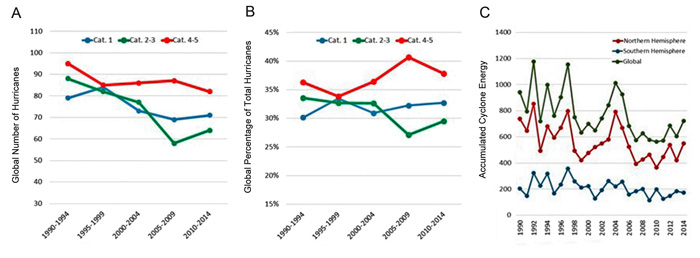| Tweet | Follow @co2science |
Paper Reviewed
Klotzbach, P.J. and Landsea, C.W. 2015. Extremely intense hurricanes: Revisiting Webster et al. (2005) after 10 years. Journal of Climate 28: 7621-7629.
Noting that Webster et al. (2005) had documented what appeared to be large increases in both the numbers and percentages of category 4 and 5 hurricanes for the conglomerate of all global ocean basins from 1970 to 2004, Klotzbach and Landsea (2015) went on to gather 10 additional years of such data in an effort to determine if these trends had continued, remained the same or possibly changed direction. And what did their efforts reveal?
The two researchers report that "when restricted to the most recent 25 years (1990-2014) with the most reliable and homogeneous records, the following conclusions are reached and illustrated in the figure below:" (1) "small, insignificant decreasing trends are present in category 4-5 hurricane frequency in the Northern Hemisphere and globally, while there is virtually no trend in Southern Hemisphere frequency," that (2) "small, insignificant upward trends are present in category 4-5 hurricane percentages in the Northern Hemisphere, the Southern Hemisphere, and globally," and, last of all, that (3) "large, significant downward trends are present in accumulated cyclone energy (ACE) in the Northern Hemisphere, the Southern Hemisphere, and globally."

(A) Pentad total of the number of hurricanes that achieved a maximum intensity of each category grouping as delineated by the Saffir-Simpson scale. (B) As in (A), but for the percentage of total hurricanes achieving each category grouping.(C) Global and hemispheric ACE values (104 kt2). Adapted from Klotzbach and Landsea (2015).
In light of these diverse findings, Klotzbach and Landsea conclude their paper by noting that prior to 1990, pertinent records are "incomplete and lead to a distorted view of the actual activity that occurred before that time," while as for the future, they suggest that "given the large natural variability driven by ENSO and other natural phenomena, it is likely to be challenging to confidently ascribe an anthropogenic signal to changes in the most intense tropical cyclones for the next several decades."
Reference
Webster, P.J., Holland, G.J., Curry, J.A. and Chang, H.-R. 2005. Changes in tropical cyclone number and intensity in a warming environment. Science 309: 1844-1846.




